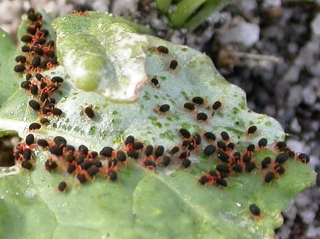GRDC Perth Research Updates 2023 – Entomology
The 2023 GRDC Grains Research Updates, held at Crown Perth on February 27 and 28, showcased the latest research and results from across the grains industry.
Several Crop Protection researchers from the Department of Primary Industries and Regional Development (DPIRD) were among the industry experts presenting on a variety of topical issues.
In this issue of Protecting WA Crops we spotlight the presentations delivered and papers published by the DPIRD entomology team.
Russian wheat aphid thresholds in WA and using biological control for RLEM
At a glance:
- Testing of the Russian wheat aphid (RWA) action threshold calculator revealed it accurately predicts if yield loss will occur under WA growing conditions. If thresholds are exceeded by 2%, RWA caused approximate losses of $136/ha.
- Previous trials have shown French Anystis mite (FAM), a biological control agent of redlegged earth mite (RLEM), can reduce RLEM in spring by 80%. For FAM to survive and spread, it requires the presence of refuges that are neither cropped nor sprayed.
Russian wheat aphid

Russian wheat aphid (Diuraphis noxia) was first found in Western Australia in 2020 and is a pest of wheat and barley. Other non-crop hosts include many grass weeds such as brome and barley grass.
The adult Russian wheat aphid (RWA) is lime-green with an elongated body about 1.4 -2.3mm in length and short antennae. They are distinguishable from corn and oat aphids by their lack of siphunculi (exhaust pipes).
The RWA injects toxins into the plant during feeding which retards growth, and with heavy infestations, can kill the plant. Crops infected with RWA can appear purplish and develop longitudinal yellowish and whitish streaks from feeding damage, even with very low numbers of RWA. However, yield loss from RWA is determined by the length of time RWA are in the crop and the percentage of tillers with RWA, not the appearance of feeding damage symptoms.
The Russian wheat aphid action threshold calculator, produced by the Grains Research and Development Corporation (GRDC), is a tool to aid in determining if RWA have reached threshold levels and if control is required. As RWA is relatively new to WA, the calculator had yet to be tested under WA conditions. In a Department of Primary Industries and Regional Development (DPIRD) funded project, entomologist Svetlana Micic tested the calculator in trials in 2022.
Ms Micic found that that the predicted yield loss from the RWA action threshold calculator does predict yield loss accurately under WA conditions. Ms Micic indicated that it was important to get an accurate assessment of percentage of tillers with RWA and not use plant damage symptoms as a measure of RWA presence.
Trial results show that the application of seed dressings prevents threshold feeding damage levels being reached. Where seed dressings weren’t applied, RWA were 11 times more likely to be detected on tillers with feeding damage thresholds met by late tillering.
More information on the Russian wheat aphid threshold calculator can be found in Svetlana’s Research Updates abstract: Russian Wheat Aphid thresholds in WA and using biological control for RLEM.
For more information on Russian wheat aphid refer to DPIRD’s Russian wheat aphid: Production pest webpage.
Biological control of Redlegged earth mites
Organophosphate (e.g. omethoate; Group 1B) and synthetic pyrethroid (e.g. bifenthrin; Group 2A) insecticides cannot be relied on to effectively control Redlegged earth mite (RLEM) long term. Alternative control measures need to be considered.
The French Anystis mite (FAM) was first introduced from France as a biological control agent for RLEM by CSIRO at four sites in 1965.
In the late 1980’s the then Department of Agriculture (DOA) relooked at FAM and found it had only survived at two sites. Trials found that > 40 FAM per square metre were needed to cause a 70-80% reduction in RLEM populations in spring. FAM were found to spread on average 45m per year.
Between 1988-1991, DOA released FAM at 36 sites between Coorow and Augusta but surveys finalised in 1994 found FAM only established at 22 of those sites.
In 2021, the Department of Primary Industries and Regional Development (DPIRD) conducted surveys in WA to determine the persistence of FAM. This was part of a national project co-funded by the Grains Research and Development Corporation (GRDC) and led by Cesar Australia. The University of Melbourne also took part in this project. DPIRD entomologist Svetlana Micic, who led the project, found that FAM were only present at ten of the original release sites, with nine of those sites being long term pasture paddocks. Two of the nine long term pasture sites had a history of in-frequent organophosphate insecticide applications.
Ms Micic discovered that FAM had only spread from the original release site if there was a pasture paddock or weedy refuge directly adjacent. Where the release sites were cropped, FAM could not be found in the weeds on fence lines or laneways, only in refuges in the paddock that couldn’t be sprayed, such as drains. She said the results of the surveys indicate that FAM will only persist in paddocks and aid in biological control of RLEM if the paddock is not cropped or if there are weedy refuges that are not sprayed with herbicides or insecticides within the cropped paddock.
Nursery sites have been established to allow interested growers to collect FAM for release on their own properties.
For more information refer to Ms Micic’s Research Updates Russian Wheat Aphid thresholds in WA and using biological control for RLEM abstract or listen to the Grains Convo podcast, due to be released on the April 1, 2023, where Ms Micic and agronomist Brent Pritchard discuss RLEM and its biological control.

